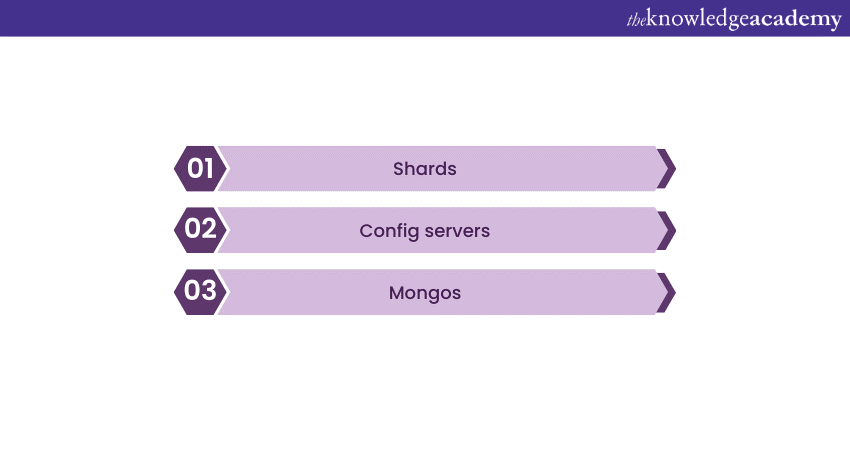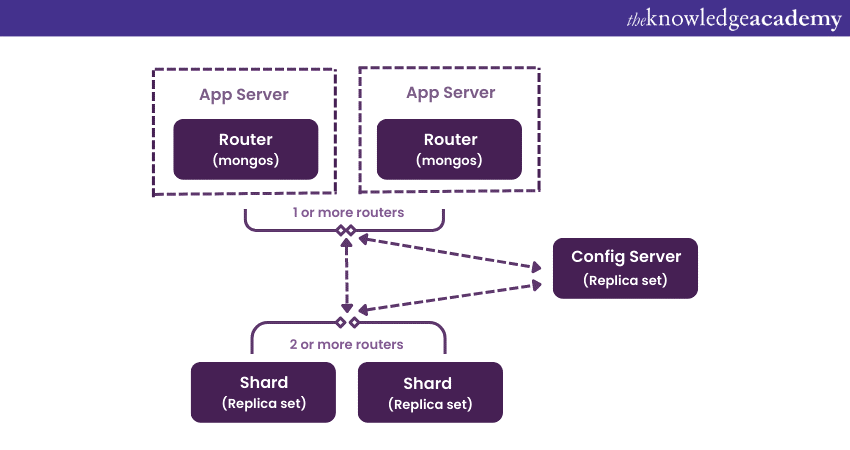We may not have the course you’re looking for. If you enquire or give us a call on +971 8000311193 and speak to our training experts, we may still be able to help with your training requirements.
Training Outcomes Within Your Budget!
We ensure quality, budget-alignment, and timely delivery by our expert instructors.

Sharding is a fundamental concept in modern Database Management. It offers a powerful solution for handling large volumes of data. When MongoDB Sharding is used, a leading NoSQL database, Sharding becomes even more effective. If you want to know how to handle massive data effectively, you have come to the right place.
MongoDB Sharding addresses this challenge, enabling data distribution across multiple machines for optimal performance. MongoDB Sharding significantly improves the database's performance by dividing data across multiple servers. Especially when dealing with huge volumes of data, it offers increased capacity, high availability, and efficient Data Management. Wondering what Sharding in MongoDB is? Check out this blog, where we discuss the concept of MongoDB in detail and learn how to implement Sharding step-by-step.
Table of Contents
1) A brief overview of MongoDB Sharding
2) What are the components of Sharding in MongoDB?
3) How to implement Sharding in MongoDB step-by-step?
4) Benefits and limitations of Sharding MongoDB
5) Conclusion
A brief overview of MongoDB Sharding
MongoDB Sharding is a strategy for dealing with massive amounts of data. This works by distributing the data across multiple servers or 'shards.' Each shard functions as a separate database. Collectively, these shards make up a single logical database. This concept is integral to MongoDB's horizontal scaling feature, which enables the database to handle massive data growth and the associated operational workload efficiently.
The process of MongoDB Sharding involves designating a 'shard key,' which serves as the basis for distributing data across the different shards. MongoDB automatically balances the data distribution by splitting the collection into smaller, manageable chunks based on the shard key. This process, known as 'auto-Sharding,' ensures that no single shard becomes overloaded with data.
Unleash your App & Web Development potential with our App & Web Development Training.
What are the components of Sharding in MongoDB?
Now, we have got a good idea about what sharding is in MongoDB. However, to get all-rounded information on it, let us now discuss the components of Sharding in MongoDB:

1) Shards: Shards are the fundamental components in MongoDB Sharding. They are essentially MongoDB instances that hold data. In a sharded cluster, data is distributed across multiple shards, each functioning as a separate database. Each shard may contain just a part of the entire dataset, and collectively, the shards constitute the complete database. Shards offer horizontal scalability and are crucial for ensuring high availability and data consistency.
2) Config servers: Config servers are another essential component of it. They store the metadata and configuration settings for the sharded cluster. Metadata includes information about the organisation of chunks (i.e., pieces of data split based on the shard key) and their distribution across different shards. This information is vital for directing queries to the appropriate shards and maintaining the overall organisation of data in the sharded cluster.
3) Mongos: Mongos instances act as query routers in the MongoDB Architecture. They provide an interface between the client applications and the sharded cluster. When a client application sends a query, the Mongos instance directs it to the appropriate shard(s) based on the metadata information stored in the config servers. This routing process ensures that database operations are efficiently performed across the distributed dataset.
Dive into the world of NoSQL databases by registering in our MongoDB Developer Course.
How to implement Sharding in MongoDB step-by-step?
We discussed the various components of Sharding in MongoDB. Now we will discuss how Sharding works in MongoDB:

1) Shard key selection: The first step in MongoDB Sharding is the selection of a shard key. A shard key can be any field (or fields) in a MongoDB document. It acts as the basis for distributing the data across different shards. The choice of the shard key is a significant decision as it influences the balance of data and load across the shards, directly impacting the performance and efficiency of the sharded database.
2) Chunk creation: MongoDB divides the data into chunks once a shard key is chosen. Each chunk contains a range of shard key values. For example, if 'user_id' is chosen as the shard key, one chunk might contain all the documents where 'user_id' falls between 1 and 1000, the next chunk between 1001 and 2000, and so on.
3) Chunk distribution: MongoDB distributes the chunks across the available shards after the chunks are created. This ensures that each shard holds a subset of data. The distribution aims to achieve a balance wherein each shard carries an equal load. This leads to enhancing the database's performance and efficiency.
4) Query routing: When a client application issues a query, a Mongos instance (query router) receives it. The Mongos checks the metadata stored in the Config Servers to determine which shard (or shards) contain the relevant data. It then routes the query to the appropriate shard(s).
5) Balancing: MongoDB automatically monitors the size and distribution of chunks across the shards and performs a balancing act if necessary. MongoDB will redistribute the chunks to maintain an even data distribution if a particular shard becomes too large. This process, known as 'auto-Sharding,' ensures the system's optimal performance.
Level up your coding skills by registering for our Node.JS Developer Course.
Benefits and limitations of Sharding MongoDB
Due to the generation of large amounts of data, managing them and correctly storing the information is crucial in any organisation. However, Sharding in MongoDB has both its benefits and limitations.
Benefits of Sharding MongoDB
Here we will discuss the benefits of Sharding MongoDB:

1) Improved performance: MongoDB Sharding improves overall system performance by distributing data and loading over multiple servers. This means that read and write operations can be conducted in parallel across different machines. This significantly reduces the time taken to process queries.
2) Horizontal scalability: Sharding offers horizontal scalability. As your data grows, you can add more servers or shards to distribute the load instead of upgrading your server (vertical scaling).
3) Efficient Data Management: With Sharding, MongoDB can handle vast amounts of data efficiently. This is particularly useful for big data applications and systems that generate large amounts of data in real-time.
4) High availability: Sharding also contributes to high availability. If one shard fails, the other shards can still operate, and the system can continue functioning. Each shard can be a replica set, providing data redundancy, backup, and automatic failover.
5) Geo-distribution: Sharding allows for geo-distribution of your data. This means you can store data physically closer to your users' location. Thus, it reduces latency and improves user experience.
6) Flexible growth: Sharding enables the flexible growth of your database. You can initially start with a few shards and then increase them as your data grows, allowing you to scale out on-demand and control costs more effectively.
7) Improved fault isolation: If one shard fails, the failure’s impact is isolated to that shard only, and it won't bring your entire system down. This leads to improved application availability and reliability.
8) Efficient query handling: With Sharding, queries can be processed by a single shard that contains the relevant data instead of all the servers in the database. This makes query handling more efficient and reduces the system load.
9) Optimised resource utilisation: By distributing the database load among multiple servers, Sharding optimises resource utilisation. This avoids the overloading of any single server and extends the useful life of your hardware.
10) Lowered risk of data loss: With sharded clusters, even if one shard encounters issues, your data still exists on other shards. This means there is a lesser risk of complete data loss.
11) Ease of maintenance: Each shard operates independently. It makes it easier to maintain and manage. You can upgrade, add, or repair shards individually without impacting the entire database system.
Limitations of Sharding in MongoDB
Now we are going to discuss the limitations of Sharding in MongoDB:
1) Complexity: Implementing Sharding can be complex. Determining the appropriate shard key, managing distributed data, and maintaining the system can be intricate and challenging.
2) Shard key selection: Choosing the right shard key is critical to balance the load evenly across shards. An inappropriate shard key can lead to unbalanced data distribution, resulting in some shards having a higher load than others.
3) Maintenance overhead: Running a sharded cluster includes additional overhead for configuration and maintenance. You'll need to monitor and manage the individual servers and the sharded cluster as a whole.
4) Transaction limitations: Transactions that affect multiple shards can be more complex and slower to process. As of MongoDB version 4.2, multi-document transactions are available across multiple shards. However, they require careful handling to ensure atomicity and consistency.
5) Inflexibility of shard key: Once a shard key is selected and Sharding is implemented, changing the shard key can be quite challenging. This lack of flexibility can lead to issues if the initial shard key selection doesn't effectively distribute data as the database grows.
6) Increased infrastructure and operational costs: Sharding requires multiple servers, which can increase infrastructure costs. Additionally, it requires careful management, which could increase operational costs.
7) Requirement for additional components: MongoDB requires additional components like config servers and mongos instances for Sharding to work. These components add to the complexity and overhead of the system.
8) Difficulty with certain queries: Certain types of queries can be more complex with Sharding. For example, queries that need to perform a join operation on documents located on different shards could experience slower performance.
9) Sharding overhead: The initial setup and the ongoing management of sharded clusters require considerable effort and planning. This includes maintaining balanced data distribution, effectively routing queries, and managing failover.
10) Range deletion slowdown: When a large range of shard key values is deleted, the performance can be slower than expected. This is because MongoDB needs to ensure the consistent state of the chunks, which takes time.
11) Potential latency issues: Network latency can become a significant factor in certain situations. This is especially true in geographically distributed Sharding environments. This is where shards are hosted in different geographical locations.
Conclusion
MongoDB Sharding is a potent feature for managing large data sets. This provides benefits like improved performance, horizontal scalability, and high availability. However, it also brings complexity and maintenance overhead. Therefore, it's essential to consider both its advantages and challenges to utilise Sharding in MongoDB effectively.
Frequently Asked Questions
Upcoming Programming & DevOps Resources Batches & Dates
Date
 MongoDB Certification Course
MongoDB Certification Course
Fri 21st Feb 2025
Fri 25th Apr 2025
Fri 20th Jun 2025
Fri 22nd Aug 2025
Fri 17th Oct 2025
Fri 19th Dec 2025







 Top Rated Course
Top Rated Course



 If you wish to make any changes to your course, please
If you wish to make any changes to your course, please


